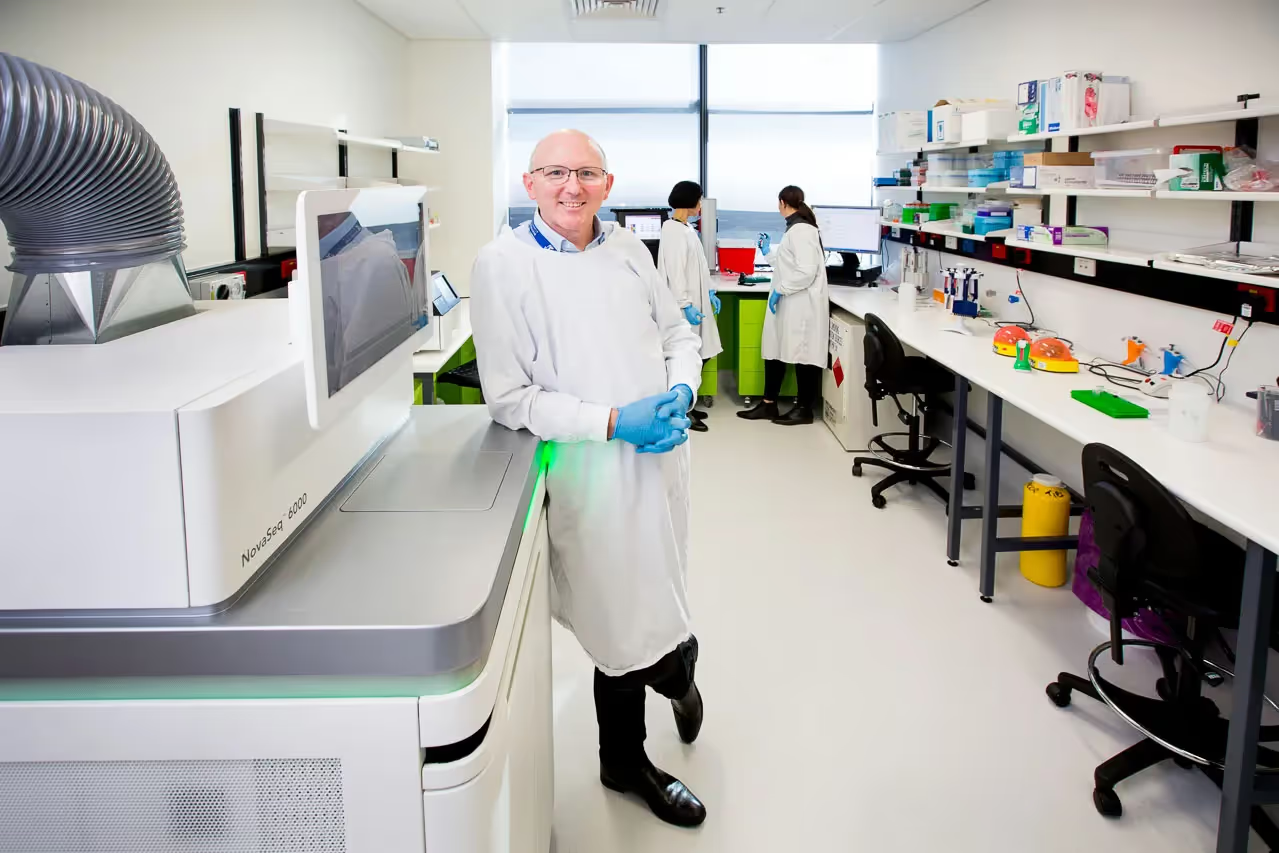For many years, a traditional tissue biopsy has been the go-to way to find or diagnose cancer. But for some people, this isn’t a safe or viable option.
The University of Melbourne has partnered with global biotech company Illumina to pioneer new possibilities for patients living with some of the rarest and most aggressive types of cancer, including a way to collect tumour information from a simple blood test known as a ‘liquid biopsy’.
Together, we formed The Advanced Genomics Collaboration (TAGC) to support the translation of genomics research in the Melbourne Biomedical Precinct.
The TAGC team recently received full diagnostic accreditation through the National Association of Testing Authorities (NATA) to perform ‘ctDNA profiling’ analysing tumour DNA collected via liquid biopsy. It’s a crucial step towards making advanced genomics testing more affordable and accessible.
“It’s notoriously difficult to perform tissue biopsies on people diagnosed with certain cancer types, including lung,brain, or prostate cancer,” explains Professor Sean Grimmond, director of the University of Melbourne Centre for Cancer Research, and TAGC’s Clinical Genomics Platform lead.
“Liquid biopsies offer a way to decipher small amounts of cancer-specific genetic mutations in the bloodstream known as circulating tumour DNA (or ctDNA). Compared with tissue sampling, this process can drastically reduce time to diagnosis, allowing earlier cancer detection,more accurate surveillance, and monitoring of recurrence. It can also identify early stages of developing drug resistance.”
The NATA tick of approval is a globally-recognised symbol signifying that TAGC’s work using liquid biopsies has undergone rigorous testing and meets a high benchmark of quality. It positions the procedure to move beyond the research lab into routine healthcare.
Illumina’s Commercial Lead for Oceania, Simon Giuliano, hopes to make these advanced procedures more widely available. “Genomics, especially next generation sequencing, can lead to better health outcomes,” he said.
“We are committed to working with government, patients and the medical community to integrate genomics as a standard of care in the fight against cancer.”

Liquid biopsies and ctDNA testing have proven especially useful in studying Cancer of Unknown Primary (CUP), where it is not possible to identify where in the body a patient’s cancer has originated from,despite extensive investigation.
Approximately 2,400 Australians are diagnosed with CUP each year, making it the 14th most common cancer diagnosis. Of this group, only 13 per cent of patients survive five years or more, making CUP the sixth most common cause of cancer-related deaths.
These difficult to diagnose cases are being looked at by Associate Professor Richard Tothill’s SUPER-NEXT study in the Rare Disease Oncogenomics laboratory, which utilises TAGC’s whole genome sequencing technology to predict tissue of origin and guide diagnosis for patients with CUP.
“Resolving a patient’s cancer type diagnosis is an important question and one of high priority for both the clinician and patient,” says Associate Professor Tothill.
“Treatments can differ substantially based on the originating cancer type, while failure to diagnose a patient’s primary cancer can also restrict access to certain types of precision medicines.”
The results of these genetic tests are analysed through a series of round-table discussions between curators,scientists, expert pathologists and clinicians, before being presented back to the patient’s clinician to help guide case management and create specialised treatment and clinical trial options.

The SUPER-NEXT study has found that genomics,especially whole genome sequencing, can resolve up to two thirds of CUP case diagnosis. Approximately 30-40% of patients have mutations or mutation features that can also help predict their response to targeted treatments.
Access to the Illumina TruSight Oncology 500 next-generation sequencing (NGS) assay means CUP patients who do not have tumour tissue suitable for surgical collection do not miss out, as the process offers the sensitivity and specificity researchers need to perform comprehensive genomic profiling of tumour samples detected in the bloodstream.
“So far we have analysed 22 patients using liquid biopsy who would not otherwise have been able to receive testing,” says Associate Professor Richard Tothill.
“Of this group, we were able to detect a potentially clinically significant variant in 82% of cases and identify clinical trial options for more than 45%.”
“We recently had a case where there was bone-only disease considered unsafe to perform a tissue biopsy. Through performing genome sequencing on a liquid biopsy sample, we were able to detect a potentially actionable BRAFV600E driver variant and identify seven possible clinical trials for the patient.”

Another advantage of liquid biopsy testing is its speed.
“It takes almost two weeks on average to source tissue samples from pathology archives,” says Associate Professor Tothill.
“Taking blood is quicker, easier, and much less invasive than taking a tissue biopsy – reducing morbidity for the patient.”
While a tissue biopsy requires specialised equipment and trained radiologists,a blood sample can be taken at most clinics by a nurse or phlebotomist, making it easier for people living in remote communities with limited access to advanced imaging and surgical biopsies.
There are plans to test the utility of rapid, non-invasive ctDNA screening in patients across the VCCC Alliance’s regional partners, and the University of Melbourne’s rural clinic campuses.
And that’s just the beginning.
According to Professor Grimmond, “Liquid biopsies have the potential to offer cutting-edge genomic testing and treatment options to patients who do not have tumour tissue suitable for surgical collection.”
“Implementation of this approach would provide diagnostic certainty and actionable insights for thousands of additional cancer patients who might otherwise fall through the cracks every year.”
